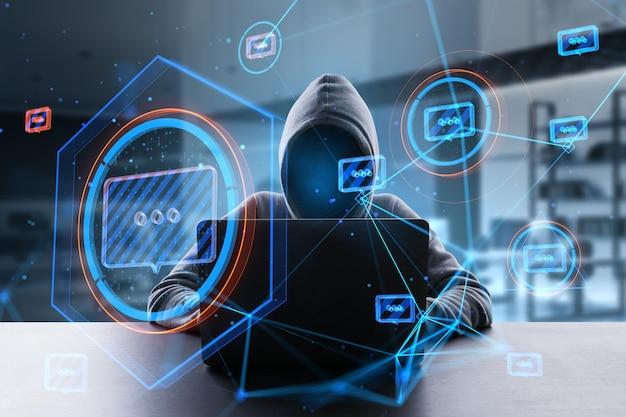Hey there, fellow digital explorers! In an age where our lives are intertwined with the virtual realm, it's crucial to have a shield against lurking threats. Today, we're on a mission to equip you with practical steps to safeguard yourself from cyberattacks. So, grab your cyber armor, and let's embark on this journey of digital defense!
1. Stay Informed: Knowledge is Power
The first line of defense is arming yourself with knowledge. Stay updated about the latest cyber threats and common attack techniques. Follow reliable tech news sources, and keep an eye out for security updates for your devices and applications.
2. Strong, Unique Passwords: Your Digital Fortress
Think of a strong password as the moat around your castle. Use a mix of uppercase, lowercase, numbers, and symbols. And for the love of cybersecurity, avoid "password123"! Consider using a passphrase, a combination of words, or a sentence that's easy for you to remember but hard for others to guess.
3. Two-Factor Authentication (2FA): Double Down on Security
2FA is like having a second lock on your digital doors. It adds an extra layer of protection by requiring not just a password, but also a second form of authentication, like a code sent to your phone. Enable 2FA wherever possible, especially for critical accounts like email and banking.
4. Beware of Phishing: Don't Take the Bait
Phishing attacks often come disguised as legitimate emails or messages. They lure you into revealing sensitive information or clicking malicious links. Be skeptical of unexpected emails, especially those asking for personal details or urging urgent action. Verify the sender's legitimacy before taking any action.
5. Update, Update, Update: Patch Your Digital Armor
Are those software updates popping up? Don't ignore them! They often contain crucial security fixes that shield your devices from known vulnerabilities. Keep your operating system, apps, and antivirus software up-to-date to stay ahead of potential threats.
6. Secure Your Wi-Fi: Lock the Gateway
Your Wi-Fi is the gateway to your digital realm. Set a strong, unique password for your router, and change the default login credentials. Use WPA3 encryption if possible, and consider hiding your SSID (network name) to add an extra layer of obscurity.
7. Firewall: The Digital Bouncer
Activate your device's firewall to filter incoming and outgoing traffic. It acts like a digital bouncer, allowing trusted data to enter and exit while keeping suspicious activity at bay.
8. Back Up Your Data: Safety Net for the Digital Age
Imagine your files as digital treasures. Regular backups ensure you don't lose them in the event of a cyberattack. Use cloud storage, external hard drives, or both for an extra layer of protection.
9. Privacy Settings: Lock Down Your Digital Footprint
Review and adjust the privacy settings on your social media accounts, apps, and devices. Limit the information you share publicly, and be cautious about granting unnecessary permissions.
10. Educate Your Inner Circle: Share the Knowledge
Cybersecurity isn't a solo mission. Share these tips with family, friends, and colleagues. Together, we create a safer digital environment for everyone.
11. Secure Your Mobile Devices: Fortify Your Digital Outposts
Our phones are like mini-computers, and they need protection too. Install security apps, keep your operating system and apps updated, and be cautious when downloading apps from third-party sources.
12. Encrypt Sensitive Data: Lock It in a Digital Safe
Encryption is like putting your data in a virtual safe. It scrambles information, making it unreadable without the correct key. Use encryption tools or services, especially for sensitive files or communications.
13. Be Wary of Public Wi-Fi: It's a Cyber Wilderness
Public Wi-Fi can be a hotbed for cyber predators. Avoid accessing sensitive accounts or conducting transactions on unsecured networks. If you must use public Wi-Fi, consider using a virtual private network (VPN) to add an extra layer of security.
14. Regularly Monitor Your Accounts: Be the Cyber Detective
Keep an eye on your financial and online accounts for any suspicious activity. The sooner you catch irregularities, the quicker you can take action to mitigate potential damage.
15. Limit Information Sharing: Guard Your Digital Identity
Resist the urge to overshare personal information online. Cyber attackers can use seemingly harmless details to build a profile and potentially exploit your identity.
16. Use Secure Connections: The Digital Handshake
Ensure websites you visit use secure connections (look for "https://" in the URL). Avoid entering sensitive information on non-secure sites. This helps safeguard your data from interception during transmission.
17. Practice Safe Clicking: Navigate the Web Wisely
Hover over links to see their destination before clicking. Avoid suspicious links in emails or messages, and be cautious when visiting unfamiliar websites.
18. Regularly Review Your Financial Statements: Be the Watchful Guardian
Keep an eye on your bank and credit card statements for any unauthorized transactions. The quicker you spot irregularities, the faster you can take action to rectify the situation.
19. Use Anti-Malware Software: Your Digital Shield
Quality anti-malware software acts as a guardian for your devices, detecting and neutralizing threats before they can wreak havoc.
20. Report Suspicious Activity: Be the Cyber Vigilante
If you encounter suspicious emails, messages, or websites, report them to the relevant authorities or the platform in question. Your vigilance could help prevent others from falling victim to cyberattacks.
21. Stay Skeptical: Trust, but Verify
If something seems too good to be true or raises a red flag, trust your instincts. Don't be afraid to double-check, verify, and question the legitimacy of digital requests.
By adopting these practices, you're building a robust defense against cyber threats. Remember, cybersecurity is a shared responsibility, and every individual plays a vital role in creating a safer digital environment. Together, we're a formidable force against cyberattacks.
